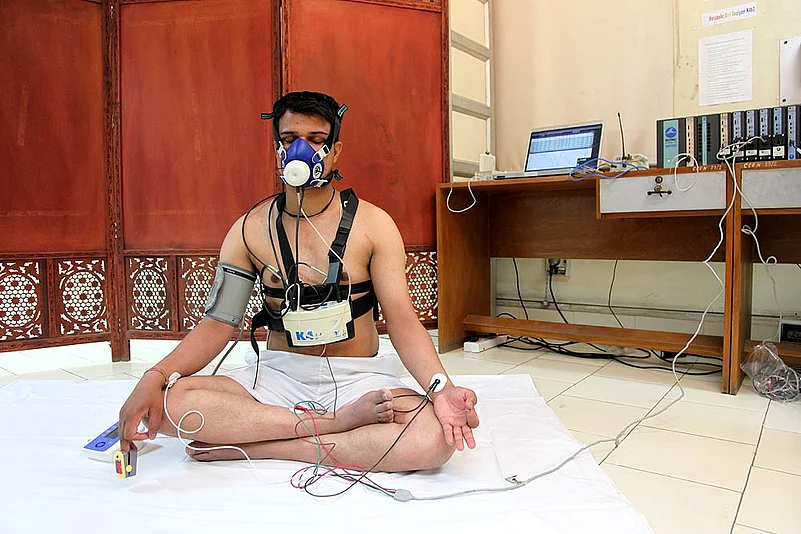The biggest obstacle in tackling hypertension, by most accounts, is the lack of awareness about the condition which, according to the World Health Organisation (WHO), affects one in five adults globally. The prevalence of hypertension, or raised blood pressure, in India is over 30 per cent, but experts say that checking one’s blood pressure isn’t a common practice yet, even though hypertension doesn’t necessarily have symptoms.
“Most of the time, the symptoms that people usually associate with hypertension aren’t correct,” says Dr Narsingh Verma, secretary general of the Indian Society of Hypertension. He says it’s common enough to associate a hot-headed person with high-blood pressure but that needn’t be the case. “Those with high blood pressure can be calm and quiet and those who have normal blood pressure can be very aggressive in nature. That’s the nature of the person and not blood pressure,” says Verma. Only measurement can determine blood pressure.
“So, our slogan is ‘know your numbers’. If your blood pressure is more than 140/90, you will require treatment and that treatment has to be monitored,” says Verma. It needs monitoring because of the daily, weekly and even seasonal variations that will influence a drug’s effectiveness. “We are trying to promote the idea that one should at least know their numbers. And once they know that, we educate them about the non-pharmacological measures to control blood pressure,” he adds. Broadly, these measures involve reducing the intake of salt, increasing the amount of exercise and a healthy diet. Much of the research on hypertension is focused on dietary interventions and the effective and economical treatment for the condition.
Hypertension, like many conditions, directly relates to lifestyle. Both forms of hypertension—essential and secondary—are known to contribute to vascular diseases in various organs like the kidneys, brain or the heart.
According to the WHO, in nearly all high-income countries, widespread diagnosis and treatment with low-cost medication have led to a significant drop in the proportion of people with raised blood pressure as well as the average blood pressure across populations. Hypertension is believed to cause about half of all deaths from stroke and heart disease. The WHO says that complications from hypertension account for 9.4 million deaths worldwide every year. The global health body also says it is possible to prevent about 2.5 million deaths each year if global salt consumption were reduced to the recommended level. Its global voluntary target is a 30 per cent reduction in population salt/sodium intake by 2025.
A recent study by the George Institute for Global Health suggested that the consumption of salt by Indians was more than double the WHO’s maximum target of five grams per person per day. The study, which analysed data from 2,27,000 people across the country, reported that the daily salt intake of Indians older than 19 was 10.98 grams per day. It noted that salt consumption was higher in southern and eastern states of India (Tripura topped the country with an average salt intake of around 14 grams, it said). Besides, it also observed that there was no difference in salt consumption between urban and rural areas. Over the past 30 years, it noted, the average Indian diet has transformed with the result that the average intake of harmful fats, sugars and salt are now above recommended levels.
In India, hypertension is the leading risk factor for non-communicable diseases and causes 10 per cent of all adult deaths. Adult hypertension prevalence has risen dramatically over the past three decades from 5 per cent to between 20-40 per cent in urban areas and 12-17 per cent in rural areas, says Dr Sailesh Mohan, senior research scientist and associate professor at the Public Health Foundation of India. The number of hypertensive individuals is anticipated to nearly double from 118 million in 2000 to 213 million by 2025. “Of greater concern is the fact that millions more have a precursor condition called pre-hypertension, which, if left unchecked, converts to hypertension,” he says.
In some countries, like the US, a combination of strong public health programmes focused on the population and enhancing clinical care have helped bring down the proportion of people with hypertension over the years. “This has reduced hypertension related cardiovascular disease and its complications to a great extent. But there is still lot to be done,” says Mohan. For instance, the control rate (an indicator of successful hypertension management) in the best performing high income country, Canada, is only 66 per cent, he says. This means that 66 per cent of those Canadians with hypertension achieve adequate control of blood pressure below 140/90. In the US, it’s about 50 per cent.
“In India, this control rate is typically less that 20 per cent. Many people with hypertension are unaware and do not receive appropriate treatment or have their blood pressure controlled, leading to high rates of complications and avoidable events such as heart attacks and strokes,” he says. Some of the challenges in India are that the health system is yet to orient itself to address hypertension effectively and provide continued long term care as well as monitor and follow up patients. Besides, inadequate early detection, diagnosis and treatment initiation also add to the challenge, say experts.
















